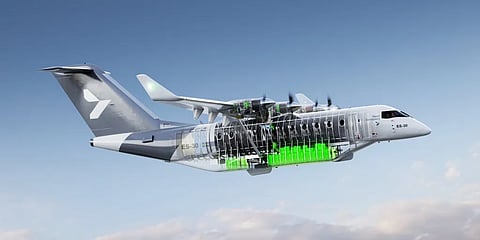Electric flight: From Tokyo to Singapore, or Paris to Moscow — on a single charge? CATL sets sights on planes
Battery giant CATL's 500Wh/kg pack could supercharge the future of electric planes

An 8-tonne aircraft with a range of 2,000 to 3,000 km, powered only by batteries?
That's up next on the to-do list of CATL, China's battery behemoth.
The company has already flown a 4-tonne plane on batteries alone.
With its new 500 Wh/kg powerbank, Chinese energy giant CATL just dropped a bombshell (the good kind): it’s working to fly planes with double the weight of an earlier project.
The secret sauce? A pack of ultra-high energy density batteries designed for use in electric aircraft — and it may have just cracked one of aviation’s biggest roadblocks.
The rig reveal
In a collaboration announced via Chinese tech outlet 36Kr, CATL revealed it’s working on a civilian manned electric aircraft project powered by its new 500 Wh/kg condensed battery.
That number might sound nerdy — but in the world of electric aviation, it’s rocket fuel.
Why it matters
Most electric vehicle batteries today hover between 150–250 Wh/kg. Aviation experts have long said 450–500 Wh/kg is the magic number needed to make fully electric planes viable.
CATL isn’t just aiming high — it says these batteries are being developed to aviation-grade standards, complete with rigorous safety, reliability, and performance testing.
Why 500 Wh/kg is a big deal
For electric planes, battery weight is everything. If your batteries are too heavy, you can’t carry passengers — or even get off the ground.
Physicists and industry officials, including Elon Musk, say at least 500 Wh/kg iss the sweet spot for batteries to power planes. CATL’s 500 Wh/kg exceeds that minimum threshold to support short-haul electric flights, which could significantly cut emissions where they’re most concentrated — like regional hops and commuter routes.
Elite battery maker
Hitting that number puts CATL in elite company.
Many have tried, but few have reached this threshold, even on the lab bench — let alone on a path to production.
Solid-state power moves
CATL (Contemporary Amperex Technology Ltd) new solution appears to lean into solid-state battery architecture, which replaces flammable liquid electrolytes with solid ones. That not only ups energy density, it could also potentially tackle a key aviation headache: safety.
Solid-state batteries offer:
Lower fire risk (huge win for aviation)
Better thermal control (critical during takeoff/climb)
Longer lifespan and stability
While firms like QuantumScape have been chasing this tech for years, CATL’s move signals it may be closer to commercial application — especially if it’s already undergoing aircraft-level testing.
CATL shifts focus
In 2024, CATL maker quietly shifted into beast mode, successfully testing a 4-tonne electric aircraft powered by its next-gen, ultra-dense battery tech.
Yep, they’re going from Teslas to takeoffs.
It all started at the Shanghai Auto Show in April 2024, when CATL unveiled its jaw-dropping Condensed Battery, packing up to 500 Wh/kg in a single cell — that’s double what your average EV battery holds.
While most of us were still admiring the shiny electric sedans, CATL was already aiming for the clouds.
The company says this breakthrough is “opening up a brand-new electrification scenario of passenger aircraft.”
Translation: electric planes are no longer sci-fi. They’re on the runway.
Team up with COMAC
To make it happen, CATL has teamed up with COMAC (Commercial Aircraft Corporation of China) and even launched its own aviation division, building everything from engines to propellers.
Fast forward to today: the 4-ton test plane? Flight complete.
Up next: an 8-tonne electric aircraft, with a projected range of 1,200 to 1,800 miles (2,000 to 3,000 km) — enough to fly from Tokyo to Singapore, or Paris to Moscow — on a single charge.
CATL says that futuristic bird could take to the skies by 2027 or 2028.
The future of flight? It’s quiet, clean, and battery-powered. And CATL’s already taxiing to the runway.
Sign up for the Daily Briefing
Get the latest news and updates straight to your inbox







